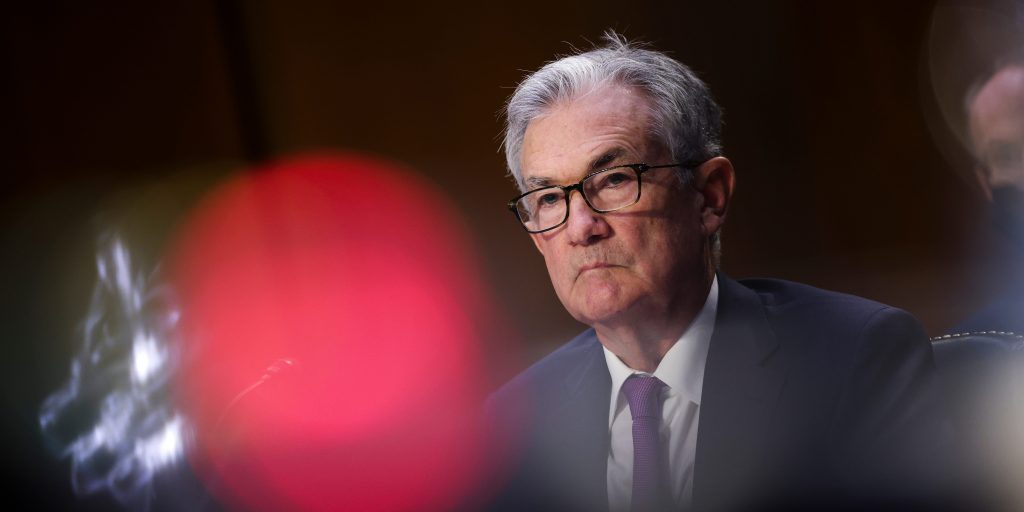- The Fed is largely expected to raise interest rates by 0.75 percentage points at its Wednesday meeting.
- The hike aims to cool inflation by bringing down demand, but it'll do little to ease gas and food prices.
- The two categories have been major drivers of inflation and are hard to rein in with monetary policy.
The Federal Reserve is days away from another policy meeting that's all but guaranteed to end in an interest rate increase. Whether it does anything to help Americans facing skyrocketing prices at the gas pump and grocery store is less certain.
The Federal Open Market Committee is scheduled to meet on July 26 and 27 to review its monetary policy and continue its fight against high inflation. That battle has ramped up in recent weeks. Inflation accelerated to a 9.1% pace in the year through June, marking the fastest price growth since 1981. The Fed escalated its efforts in June, too, raising rates by 0.75 percentage points — three times the typical 0.25 point hike seen in the last several decades — in hopes of slowing the economy and bringing demand in line with supply.
Markets have priced in another triple-sized rate hike from the Fed's coming meeting, and economists widely expect the same. The increase will place the Fed's benchmark between 2.25% to 2.50%, well above the 0% to 0.25% range seen as recently as early March.
Higher rates represent the Fed's go-to tool for slowing price growth, but they're more of a blunt tool than a precise instrument. Rate changes affect borrowing costs throughout the economy, ranging from mortgage rates to credit-card interest. Yet much of the inflation hammering Americans today comes from necessities like food and gasoline.
Food and gas prices are still unaffected by higher rates
That leaves the Fed in an awkward spot. Food and gas inflation can fly under the Fed's radar, as Americans' demand for those must-haves holds steady no matter where rates stand. That could force the central bank to raise rates even faster, but doing so risks slowing the economy to a halt.
"Fed policy cannot directly impact food or energy inflation," Seema Shah, chief global strategist at Principal Global Investors, said in a note. "As such, the Fed must continue hiking aggressively if it wants to get a handle on the inflation problem, even if it means speeding up a recession problem."
The food-and-gas blind spot is one Powell already caught flak for last month. Lawmakers on both sides of the aisle grilled the Fed chair in a late-June hearing, raising concerns of a Fed-induced recession as the central bank rushes to pull inflation lower. When Sen. Elizabeth Warren of Massachusetts asked Powell whether higher rates would lower gas prices, Powell answered with a clear "no," adding that food costs would also go unaffected.
"The question of whether we're able to accomplish [a soft landing] is going to depend, to some extent, on factors that we don't control," he later said, referring to the central bank's goal of reining in inflation without triggering a deeper downturn.
Warren pushed back against the Fed's hiking plans again in a Sunday column in The Wall Street Journal. The senator urged the central bank to slow its roll, arguing that "low unemployment and high inflation are painful, but a Fed-manufactured recession that puts millions of Americans out of work without addressing high prices would be far worse."
The period between the Fed's June and July meetings offered some encouraging signs for the committee. Gas prices have fallen for six weeks straight, bringing much-needed relief for drivers and reversing one of the biggest contributors to headline inflation. The S&P GSCI commodities index has also fallen to levels last seen before Russia's invasion of Ukraine. The declines signal the July inflation print could show inflation slowing and give the Fed some flexibility with which to continue raising rates.
Still, that report isn't due for two weeks. The Fed is poised to bring rates close to neutral levels on Wednesday afternoon, and as recession fears loom large, July economic data will reveal whether the central bank will keep its foot firmly on the brake or enjoy some valuable breathing room.

